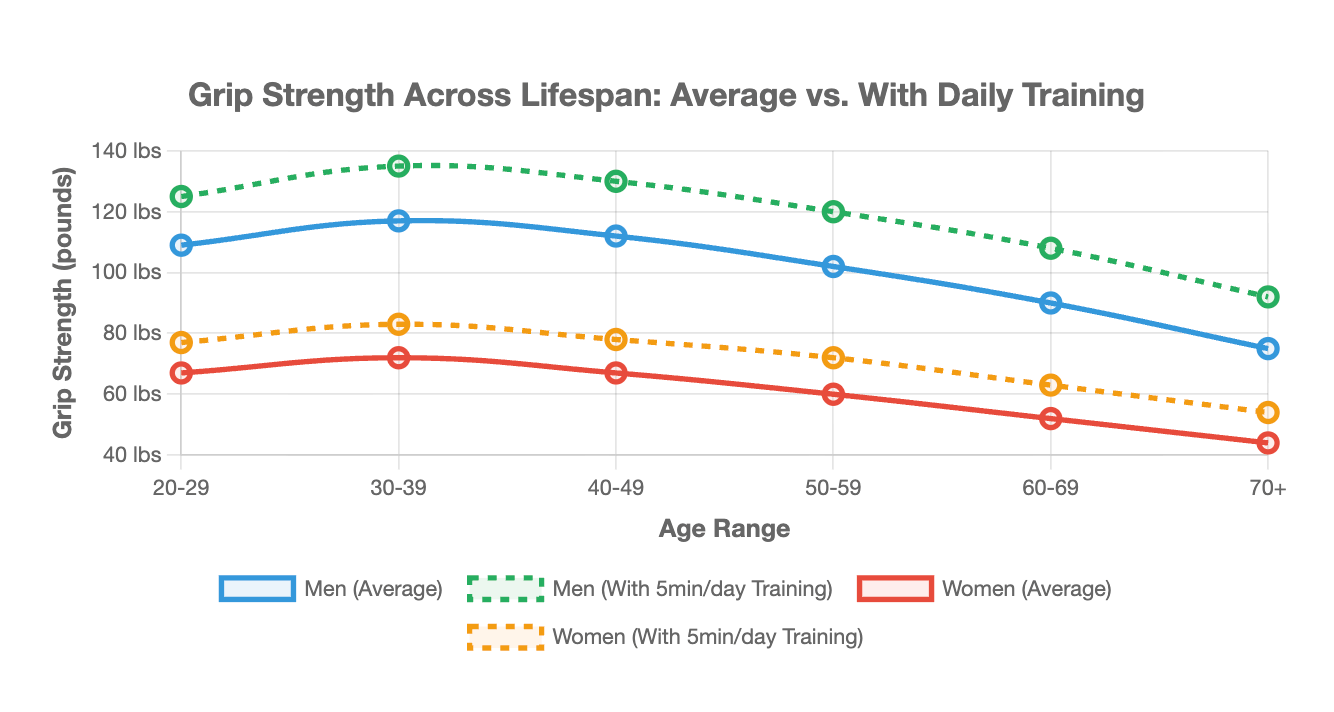🔍 The Science: What This Chart Reveals
Grip strength isn't just about opening jars—it's a biomarker for overall health and longevity. Research published in The Lancet found that grip strength is a stronger predictor of cardiovascular death than blood pressure.
Here's what the data shows across different life stages:
📈 Ages 20-29: The Building Years
- Men: Average 105-113 lbs (47-51 kg)
- Women: Average 65-70 lbs (29-32 kg)
- Rapid strength gains possible with training
- Peak athletic performance approaching
🏆 Ages 30-39: Peak Performance
- Men: Peak at ~115-120 lbs (52-54 kg)
- Women: Peak at ~70-75 lbs (32-34 kg)
- Maximum muscle mass and neural efficiency
- Optimal time to build "strength reserves" for later years
📉 Ages 40-49: The Transition
- Men: Average 110-115 lbs (50-52 kg)
- Women: Average 65-70 lbs (29-32 kg)
- Sarcopenia (muscle loss) begins
- Lifestyle factors become increasingly important
⚡ Ages 50-59: Fighting the Decline
- Men: Average 100-105 lbs (45-48 kg)
- Women: Average 58-63 lbs (26-29 kg)
- 10-15% loss from peak without training
- Daily grip training can slow or reverse this trend
🛡️ Ages 60+: Maintaining Independence
- Men: Average 85-95 lbs (39-43 kg)
- Women: Average 50-55 lbs (23-25 kg)
- Grip strength directly correlates with functional independence
- Below 60 lbs (men) / 35 lbs (women) = increased fall risk and disability
⏱️ The 5-Minute Solution: Why It Works
Why 5 Minutes Is the Magic Number
1. Neuromuscular Efficiency
Your grip strength isn't limited by muscle size—it's often limited by neural activation. Five minutes of focused training daily creates new neural pathways faster than longer, infrequent sessions.
2. Recovery Time
Hand and forearm muscles recover in 24-48 hours. Brief daily sessions prevent overtraining while providing consistent stimulus.
3. Habit Formation
Five minutes is sustainable. You can train while watching TV, during work breaks, or before bed. Consistency beats intensity for long-term gains.
4. Tendon Adaptation
Tendons strengthen slowly. Daily light-to-moderate training builds tendon strength better than intense weekly sessions that risk injury.
📋 The 5-Minute Daily Protocol
| Time | Exercise | Sets x Reps |
|---|---|---|
| 0:00-1:30 | Grip Strengthener Squeezes | 3 sets x 15 reps per hand |
| 1:30-2:30 | Finger Extensions (rubber band) | 3 sets x 20 reps |
| 2:30-4:00 | Static Holds (gripper or weight) | 3 sets x 30 seconds per hand |
| 4:00-5:00 | Wrist Rotations | 2 sets x 10 each direction |
📊 Expected Results Timeline
- Week 1-2: Neural adaptation, movements feel easier
- Week 3-4: Noticeable strength increase (5-10%)
- Week 8-12: Significant gains (10-25% improvement)
- 6+ Months: Peak strength maintenance, injury prevention
🚨 Warning Signs: When Low Grip Strength Matters
Research shows concerning correlations between low grip strength and health outcomes:
| Grip Strength Level | Health Implications |
|---|---|
| < 57 lbs (men) / < 35 lbs (women) | Increased disability risk, higher mortality rate |
| < 65 lbs (men) / < 40 lbs (women) | Elevated cardiovascular disease risk |
| < 72 lbs (men) / < 44 lbs (women) | Higher hospitalization rates |
🛠️ Tools for Your 5-Minute Daily Routine
You don't need a gym membership—just the right tools:
Essential Equipment
- Starter Grip Strengthener Pack ($14.95) - Perfect for beginners starting their daily routine
- Complete Grip Strengthener Set ($34.95) - Multiple resistance levels for progressive overload
- Digital Grip Strength Tester ($24.95) - Track progress scientifically
💰 ROI on Grip Training
Consider the cost of not training grip strength:
- Increased healthcare costs from falls and injuries
- Loss of independence requiring assisted living ($4,000+/month)
- Reduced quality of life and physical capabilities
- Lower earning potential in physical jobs
Investment: $15-35 in equipment + 5 minutes daily
Return: Decades of maintained strength, health, and independence
Start Your 5-Minute Grip Strength Journey Today
Don't wait until you notice decline. Build your strength reserves now and maintain them for life.
Shop Grip Strengtheners →Strengthen today. Stay independent tomorrow. Live better forever.





